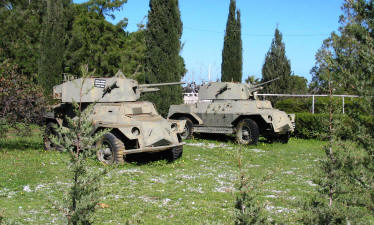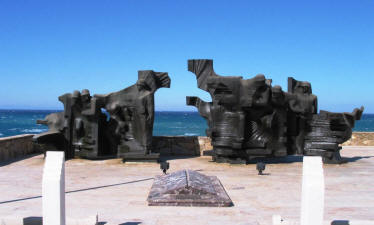Peace and Freedom Museum
Alsancak, near Kyrenia, North cyprus
 |
| Abandoned Armoured Cars |
This museum is situated at the point where the first Turkish troops landed in 1974. In order to appreciate the relevance of this museum, it might be worth having a look at a short history of events.
The claim to Greek culture on the island is made on the basis that Greeks have been the dominant race since "time immemorial". In fact the Helenistic control of the island lasted only a short period, from 325Bc to 58BC. The Roman and Byzantine periods lasted much longer, from 58BC to 1191AD.
When Christianity came to Cyprus in 46AD, it developed along the lines of Orthodox rather than Latin. In 1192, however, with the arrival of the Lusignans, the Orthodox church was oppressed, and came under the control of the Latins.
 |
| Memorial to the Fallen |
During this time, the Ottoman empire was developing, and when, in 1461, they took control of what we now know as Greece, the Greeks preserved their culture through the Orthodox church. When the Ottomans arrived in Cyprus in 1571, they freed the Orthodox church from centuries of Latin control. Over the years, the Greek influence and the control that the orthodox church had was gradually strengthened, to such an extent that there was eventually little difference between religious activities and political activities.
In 1832, after a long and bitter war, Greece was granted independence from the Ottomans. Although there had been agitations in Cyprus, the island had never really been part of the deal. However when the British arrived in 1878, there were hopes that they would grant Cyprus enosis (union with Greece). However that was not to be the case.
 |
| Monument above the Landing Beach |
From the 1930s a gradual escalation of civil unrest was seen, largely instigated by the church. In 1955, EOKA was formed as a terrorist organisation with the sole aim of getting the British out and absorbing the island into Greece. Little thought was made of what the Turkish Cypriots would think of this. EOKA violence escalated against not only the British, but against anybody that did not support enosis. Attacks against Turkish villages became more common, and in 1958, Turkish Cypriots formed TMT in order to counter EOKA.
In 1959, the London and Zurich agreements laid the foundations for the independence of Cyprus, although as we now know, this was seen by the Greek Cypriots as a stepping stone to enosis, which had not been forgotten. In 1963, a secret plan was drawn up which, would have discarded the 1960 constitution.
As part of this plan, Turkish Cypriots were gradually displaced from their villages in placed in enclaves. In December of 1963, systematic violence against Turkish Cypriots erupted, and this was to continue for several years, and separated the island into Greek and Turkish areas.
In 1974, a Greek sponsored coup overthrows Archbishop Makarios with the intention of forcing enosis onto the island.
As one of the guarantor powers, Turkey intervened to prevent this. This confirmed an already divided island into Greek Cyprus and Turkish Cyprus.
The museum is in two parts. The open air portion consists of a display of vehicles and arms left by the fleeing Greek soldiers, while indoors there is a display of photographs of the military action and uniforms of some of the participants.
Close to the museum is a small military graveyard holding the remains of some of the casualties, including that of Col Karaoglanoglu, the most senior officer to be killed in the operation, and whose name was given to the nearby village in his memory.
A short distance from the museum is a large monument at the actual point of the landings.
See the location on Google Maps
Back to Kyrenia index.